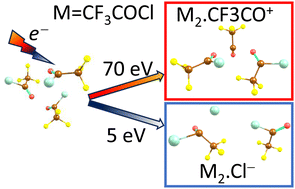Electron-triggered processes in halogenated carboxylates: dissociation pathways in CF3COCl and its clusters†
Abstract
Trifluoroacetyl chloride, CF3COCl, is produced in the Earth's atmosphere by photooxidative degradation of hydrochlorofluorocarbons, and represents a potential source of highly reactive halogen radicals. Despite considerable insight into photochemistry of CF3COCl, its reactivity towards electrons has not been addressed so far. We investigate the electron ionization and attachment in isolated CF3COCl molecules and (CF3COCl)N, max. N ≥ 10, clusters using a molecular beam experiment in combination with quantum chemical calculations. The ionization of the molecule at 70 eV electron energy leads to strong fragmentation: weakening of the C–C bond yields the CF3+ and COCl+ ions, while the fission of the C–Cl bond produces the major CF3CO+ fragment ion. The cluster spectra are dominated by Mn·COCl+ and Mn·CF3CO+ ions (M = CF3COCl). The electron attachment at energies between 1.5 and 11 eV also leads to the dissociation of the molecule breaking either the C–Cl bond at low energies below 3 eV yielding mainly Cl− ions, or dissociating the C–C bond at higher energies above 4 eV leading mainly to CF3− ions. In the clusters, the intact Mn− ions are stabilized after electron attachment at low energies with contribution of Mn·Cl− fragment ions. At higher energies, the Mn·Cl− fragments dominate the spectra, and C–C bond dissociation occurs as well yielding Mn·CF3−. Interestingly, Mn·Cl2− ions appear in the spectra at higher energies. We briefly discuss possible atmospheric implications.

- This article is part of the themed collections: Celebrating International Women’s day 2025: Women in physical chemistry and Molecular Dynamics in the Gas Phase


 Please wait while we load your content...
Please wait while we load your content...